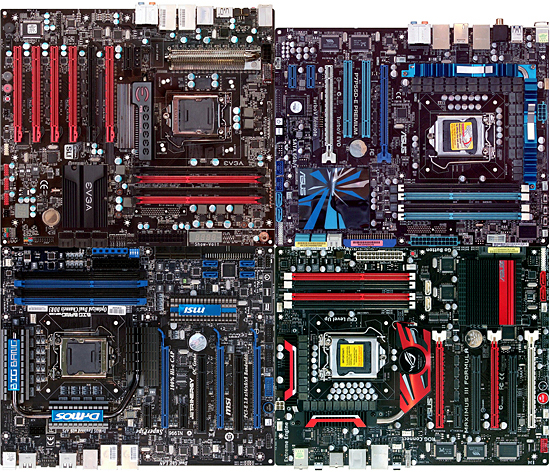Extreme P55: Four LGA 1156 Motherboards Over $250
With better efficiency and more aggressive Intel Turbo Boost binning, LGA 1156-based processors could be the right choice for some high-end machines. We look at a few premium motherboards that make these builds possible. Do they best Intel's X58 platform?
Nothing But The Best?
Nothing But The Best?
What defines a high-end system? Many proclaimed enthusiasts have expressed to us that the LGA 1156 platform simply wouldn't be a suitable starting point for them, simply because it’s not designed to host a large number of high-bandwidth devices, such as graphics cards. And yet, most games don’t need more than a single Radeon HD 5970 to play at super-high settings. Moreover, not every high-end user wants to play games all day, and companies like EVGA and MSI have a workaround for those whose graphics desires exceed what Intel's mid-range platform was really designed to do.
Setting aside the debate over P55's suitability for hosting multiple graphics cards, a few key advantages that could put a shiny new LGA 1156-based processor into the hands of a high-end user include higher efficiency, higher stock performance via improved Intel Turbo Boost ratios, better overclocking, and reduced heat output for those who desire a quiet workstation build (there's a reason Intel came to market with its Xeon 3400-series CPUs, after all).
Today’s contenders for P55 supremacy run the gamut from a $250 gamer's board with advanced overclocking features to a $280 premium model with all the latest interfaces and a $340 product that supports a nearly insane number of up to six graphics cards. Our next page details the features that each motherboard boasts in an effort to overcome the mainstream market stigma associated with P55-based platforms.
Get Tom's Hardware's best news and in-depth reviews, straight to your inbox.
-
kumaiti I will comment the same as in the previous motherboard roundup: please add more details the CODECs on each board. There is almost nothing about the Via VT2020 and many crucial features of the ALC889 are vendor-dependant. It would be really good to know if they support Dolby Digital Live, DTS connect, Dolby Headphone and so on.Reply -
dcay "Already several years old, we have yet to build a system that can overcome Crysis’ system demands at 2560x1600 and 8x anti-aliasing (AA). That makes this outdated game a solid benchmark application."Reply -
dcay "Already several years old, we have yet to build a system that can overcome Crysis’ system demands at 2560x1600 and 8x anti-aliasing (AA). That makes this outdated game a solid benchmark application."Reply -
johnbilicki So socket 1156 is supposed to be the most awesome thing in the world?Reply
- No six core CPU's, EVER.
- Requires a glued on chip for more then 16 lanes.
- Motherboards overpriced compared to socket AM3.
When you buy a socket 1156 system that is all the performance you're going go get out of it. The top-end CPU's won't come down in price by much and Intel made it clear it's a mainstream platform. My socket AM3 has playable FPS, the motherboard is high end and under $200, and I'll be able to continue upgrading in the future. That is what matters to me. The Intel fan boy articles are getting so old. -
Crashman kumaitiI will comment the same as in the previous motherboard roundup: please add more details the CODECs on each board. There is almost nothing about the Via VT2020 and many crucial features of the ALC889 are vendor-dependant. It would be really good to know if they support Dolby Digital Live, DTS connect, Dolby Headphone and so on.Reply
They don't.
johnbilickiThe Intel fan boy articles are getting so old.
It might surprise you that new motherboard series articles follow new chipsets. So AMD fanboy, where's the new AMD chipset? -
kumaiti CrashmanThey don't.Reply
1. Do you mean on these boards or in general?
2. If it is for these boards, did you install the drivers/software from each manufaturer or used the default Windows drivers?
Thanks for the reply
-
Crashman kumaiti1. Do you mean on these boards or in general?2. If it is for these boards, did you install the drivers/software from each manufaturer or used the default Windows drivers?Thanks for the replyReply
None of the manufacturers list support for DDL or DTS Connect any longer. Those technologies were most likely licensed in the past and neglected due to lack of demand and cost, because typical buyers don't know what they are and won't pay extra for them. -
dman3k Sorry, I'm not an Intel fanboy, but AMD thoroughly sucks right now. Heck, even with their top of the line 5xxx series graphics, they still can't damn write a driver.Reply
It may well be Intel's monopolize actions that got AMD to this point when AMD had the top processors, but the truth is AMD products suck right now.
There are P55 mobos under $160 that you can easily find, which will still beat AM3 systems quite handily. For example, get a DFI Lanparty P55-T36. johnbilickiMy socket AM3 has playable FPS, the motherboard is high end and under $200, and I'll be able to continue upgrading in the future. That is what matters to me. The Intel fan boy articles are getting so old. -
Crashman dman3kSorry, I'm not an Intel fanboy, but AMD thoroughly sucks right now...There are P55 mobos under $160 that you can easily find, which will still beat AM3 systems quite handily. For example, get a DFI Lanparty P55-T36.Reply
First of all, most reviewers are begging AMD to pull a rabbit out of the hat just to get the competition moving again. Second, AMD does give you more chipset for your money.

